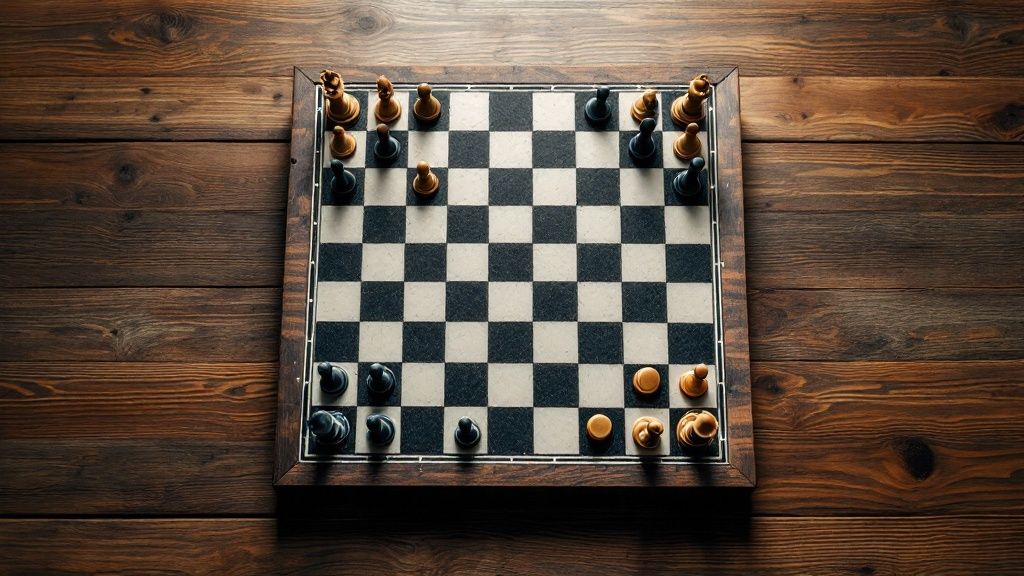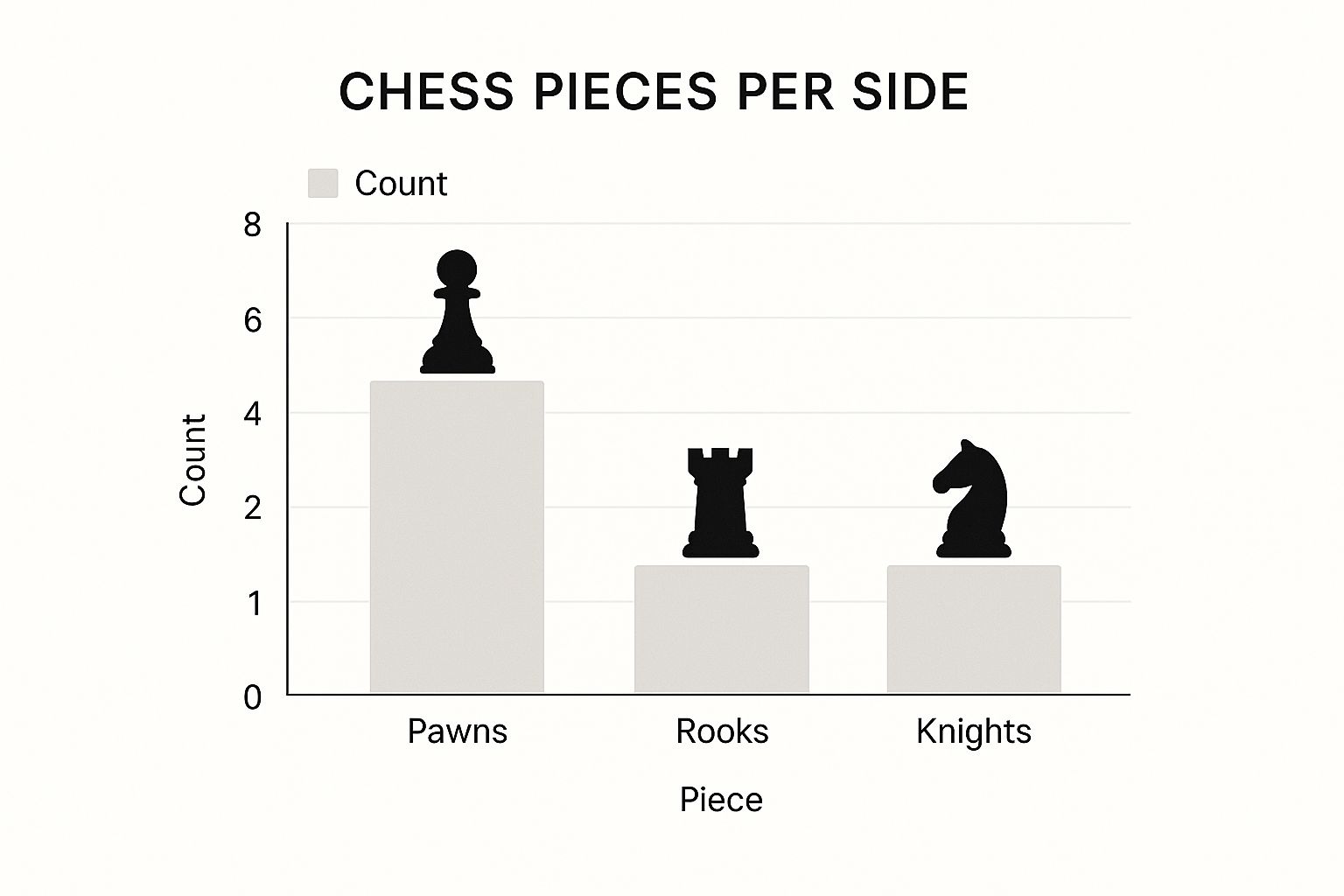Why Perfect Chess Board Setup Matters
Setting up a chessboard correctly is essential for fair and strategic gameplay. The precise placement of each piece establishes the initial balance of power and sets the stage for the tactical complexities that will follow. A correct setup ensures that the game unfolds as intended, without unintended advantages or disadvantages. Much like a building requires a solid foundation, a chess game requires a correct setup. This attention to detail is a hallmark of serious chess players, including grandmasters who meticulously verify their boards before competitive matches.
This precision is not merely a matter of following rules, but is deeply connected to the historical and structural foundations of the game itself. The chessboard, an 8x8 grid of 64 squares, originates from the ancient Indian game of chaturanga, dating back to the 6th century AD. The traditional setup ensures each player begins with 16 pieces: one king, one queen, two rooks, two knights, two bishops, and eight pawns. This arrangement is fundamental to maintaining the game's strategic equilibrium.
The Importance of Board Orientation
A frequently overlooked aspect of proper setup is board orientation. The simple "white on right" rule dictates that each player has a light-colored square at the bottom right-hand corner. This seemingly minor detail is crucial for consistent gameplay and avoids confusion. Opening strategies and tactical maneuvers often rely on the predictable location of squares relative to each player. An incorrectly oriented board can disrupt these plans and lead to unforeseen consequences.

The Impact of Incorrect Setups
Even experienced players can make setup errors. The most prevalent mistake is reversing the king and queen's positions. This seemingly insignificant error can significantly impact opening strategies and disrupt the flow of the game, even for seasoned players. Misplacing the bishops or knights, while less impactful, can still create initial confusion and disrupt planned moves. These potential errors underscore the importance of establishing a consistent and careful setup routine.
Mastering proper chess board setup, encompassing both orientation and piece placement, is a foundational skill that separates casual players from those seeking improvement. This meticulousness cultivates precision and strategic thinking, influencing every aspect of the game. By prioritizing a correct setup from the outset, players establish a solid base for their chess development, guaranteeing that every game begins on equal footing.
Mastering Chess Board Orientation
Setting up a chess board correctly is essential for a smooth and fair game. It begins with the proper orientation of the board itself, a crucial first step often overlooked by newcomers. Before any pieces are placed, ensuring the board's correct position is paramount. This seemingly minor detail can significantly influence the game's flow and strategic considerations.
The White-on-Right Rule
The fundamental principle of board orientation is the "white on right" rule. This dictates that each player should have a light-colored square at the bottom right-hand corner of their side of the board. This simple rule ensures consistency and allows players to quickly identify square locations relative to their position. Much like navigating with a rotated map can be disorienting, an incorrectly oriented chessboard can disrupt even experienced players.

Why Orientation Matters
Correct board orientation is not merely a matter of tradition or aesthetics; it has practical implications for strategic play. Many opening strategies and tactical maneuvers rely on the standard board orientation. For instance, a knight move early in the game may target a specific square assuming the standard setup. A rotated board can completely alter the intended destination of such a move, disrupting planned strategies and leading to unforeseen outcomes. Moreover, a correctly oriented board promotes familiarity and reduces cognitive load, allowing players to concentrate on the complexities of the game itself.
Common Orientation Mistakes and How to Avoid Them
Errors in orientation can happen even to seasoned players, particularly in unfamiliar settings or with non-standard boards. A common mistake is rotating the board by 90 degrees, resulting in both players having a dark square at the bottom right. Another error arises with boards featuring algebraic notation (letters and numbers). If the numbers run along the sides rather than facing each player, the orientation is incorrect. A simple check of the bottom right square before placing pieces can prevent these oversights and the resulting confusion.
To provide a quick and easy reference, the following table highlights the correct setup and common mistakes regarding chessboard orientation.
Chess Board Orientation Checklist A quick reference guide to ensure your chess board is correctly oriented
| Orientation Element | Correct Setup | Common Mistakes |
|---|---|---|
| Bottom Right Square | Light square for both players | Dark square on the right |
| Algebraic Notation | Numbers face each player | Numbers on the sides |
As this table clearly demonstrates, a quick check of these two elements can confirm the board's proper setup.
Orientation in Different Settings
While the white-on-right rule is the standard for over-the-board chess, digital chess platforms occasionally display boards incorrectly. This can be particularly confusing for beginners still learning the basics of board setup. Reputable platforms typically provide settings to adjust the orientation. Furthermore, certain chess variants or specialized setups may have their own distinct orientation rules. Always consult the specific guidelines for the variant being played. In tournament settings, the arbiter is responsible for ensuring the correct board orientation before the start of any game.
Mastering the fundamentals of chess board orientation is a prerequisite for an organized and enjoyable chess experience. By eliminating the potential for confusion arising from a misoriented board, players can focus on strategy and the pursuit of checkmate. With the board now correctly oriented, the next step is the precise placement of the chess pieces.
Piece Placement That Professionals Swear By
After correctly orienting the board, precise piece placement is the next crucial step in setting up a chessboard. This isn't simply about placing pieces; it's about developing a systematic approach that eliminates errors and builds confidence. Grandmasters understand that a consistent setup routine helps focus their minds on strategy.
Setting Up the Back Rank: A Step-by-Step Guide
The back rank, the row closest to each player, houses the most powerful pieces. Here's the precise order professionals follow:
- Rooks in the Corners: Place the rooks on the corner squares. This anchors the back rank and provides a visual starting point.
- Knights Next to the Rooks: The knights are placed immediately adjacent to the rooks.
- Bishops Beside the Knights: Position the bishops on the squares flanking the knights. Each bishop starts on a square of its own color.
- Queen on Her Color: The white queen goes on the white central square (d1), and the black queen goes on the black central square (d8). This ensures visual symmetry and strategic balance.
- King in the Remaining Square: The king occupies the final central square, completing the back rank.
This methodical approach, moving from the outside in, helps solidify placement in memory. This setup becomes second nature with practice. Additionally, professionals understand the importance of version control. For further information on collaborative workflows, explore git workflow.
The Pawn Formation: Frontline Soldiers
Once the back rank is complete, the pawns form a protective shield on the second rank (White) and seventh rank (Black). They are placed directly in front of the back-rank pieces. This formation is essential for controlling the center and launching opening strategies. The correct setup isn't only about placement but understanding the history of chess pieces. The Staunton pattern, introduced in 1849, is used universally. Learn more about the history of chess.
Visualizing the Setup: Symmetry and Patterns
The beauty of a correctly set up chessboard lies in its symmetry. Each side mirrors the other, with pieces arranged in a balanced pattern. This visual symmetry helps verify the setup.
To better understand piece placement, the following table offers a comprehensive guide to the starting positions:
Introduction to the table: The following table provides a complete guide to the initial placement of chess pieces. It details the positions for both white and black pieces, along with any special considerations.
| Piece Type | White Pieces Position | Black Pieces Position | Special Notes |
|---|---|---|---|
| Rook | a1, h1 | a8, h8 | Corners of the board |
| Knight | b1, g1 | b8, g8 | Next to the rooks |
| Bishop | c1, f1 | c8, f8 | Next to the knights |
| Queen | d1 | d8 | On a square matching the queen's color |
| King | e1 | e8 | Remaining square in the back rank |
| Pawn | a2-h2 | a7-h7 | Second rank (White), Seventh rank (Black) |
Key takeaways from the table: As the table demonstrates, each piece has a designated starting position. The queen's position is determined by its color, ensuring each queen starts on a square of the same color.

The infographic above visualizes the distribution of pieces, highlighting the number of pawns (8), rooks (2), and knights (2). Pawns play a crucial role in the early game.
Mastering Different Chess Sets
While setup principles remain consistent, different sets present unique challenges. Themed sets might require extra attention. However, whether using a traditional Staunton set or an elaborate design, the fundamental rules apply. Explore our guide on unique chess sets at MarbleCultures. Consistent practice reinforces proper habits and strengthens your setup ritual. This transforms piece placement from a potential source of confusion into confident preparation.
Setup Mistakes That Even Veterans Make
Setting up a chessboard correctly appears straightforward, yet errors occur even at the highest levels of competition. These mistakes, from the common king-queen swap to subtle board orientation issues, can have unexpected consequences. This discussion explores the psychology behind these persistent errors, examines real-world tournament incidents, and offers practical techniques for prevention.
The King-Queen Quandary: A Common Slip-Up
Perhaps the most frequent setup error is the king-queen reversal. Even seasoned players occasionally misplace these vital pieces. This seemingly minor oversight can significantly alter opening strategies and disorient even experienced players. Why does this happen? One theory suggests the similar appearance of the king and queen in certain chess sets. This visual resemblance can cause a momentary lapse in concentration, especially during hurried setups.
Additionally, some players develop habitual setup routines that, while generally effective, can become detrimental under pressure. For instance, a player may consistently place the king first, irrespective of its correct position. Under time constraints or in unfamiliar environments, this habit can lead to errors.
Board Orientation Blunders: Subtle Yet Significant
While less conspicuous than misplaced pieces, incorrect board orientation can also affect gameplay. The "white on right" rule, dictating a light square at the bottom right corner for both players, is fundamental. However, mistakes still arise, often stemming from playing on unfamiliar boards, particularly those lacking clear markings. You might be interested in exploring our collection of unique marble chess sets, all of which adhere to standard tournament regulations.
In tournament settings, incorrect orientation can be especially disruptive. Consider a player preparing a specific opening strategy, only to discover a rotated board. This can disrupt their plan and lead to unnecessary early complications.
Tournament Regulations and Arbiters
Formal chess tournaments have established rules regarding incorrect setups. Typically, if an error is discovered before the first move, it is rectified without penalty. However, if the game commences with an incorrect setup and a player notices mid-game, the arbiter must be summoned. The arbiter possesses the authority to restart the game with a correct setup or, occasionally, to permit continuation if the error is deemed inconsequential.
Avoiding Setup Errors: Practical Tips
Developing a consistent setup routine is crucial for minimizing errors. Here are some practical techniques:
- Visualize the setup: Before placing pieces, mentally envision the correct arrangement.
- Verbalize the placement: Softly stating the piece names as you position them can reinforce the correct order.
- Double-check: After setting up, quickly scan the board to verify proper placement.
- Seek feedback: If practicing with a partner or coach, have them confirm your setup.
By incorporating these tips into your chess practice, you can reduce the likelihood of setup errors and guarantee that each game starts on a solid foundation. This meticulous approach strengthens proper how to set up a chess board correctly principles and enables focus on the game itself. This mindful practice translates into stronger gameplay, allowing concentration on strategy and tactics. Furthermore, consistent adherence to proper setup protocols fosters respect for the game and enhances the overall chess experience.

Navigating Chess Variants and Special Setups
Standard chess, with its familiar arrangement, provides a solid foundation for the game. However, the world of chess extends beyond this traditional setup. Understanding correct chessboard configuration for different variants and special situations is crucial for any serious player. For instance, Fischer Random Chess (Chess960), with its 960 starting positions, challenges players to rethink opening strategies.
Adapting to Variant Rules
Many popular chess variants retain the core setup principles of standard chess but introduce unique alterations. In Chess960, despite the randomized back-rank piece arrangement, the "queen on color" rule applies. This ensures the white queen begins on a white square, and the black queen on a black. This consistency within the variety emphasizes the importance of grasping the underlying logic of chess setup. Furthermore, some variants introduce new pieces or modify existing ones, requiring attention to their initial placement. Mistakes can easily occur when exploring beyond the standard game. For further information, consider exploring resources such as Grand Canyon Bus Tours.
Tournament Conditions and Specialized Equipment
Tournament play often involves specific equipment regulations that influence proper chessboard setup. Some tournaments stipulate particular chessboard dimensions or piece styles. This standardization promotes fairness and eliminates any potential advantage from unusual equipment. Additionally, players should familiarize themselves with digital chessboards and their customizable settings, as these are becoming increasingly prevalent in competitive play.
Unusual Chess Sets and Accessibility Modifications
Beyond standardized tournaments, players may encounter unusual chess sets, ranging from themed designs to antique boards. Unique sets, such as those with Japanese inspired marble pieces, often present unique challenges, especially if the pieces deviate significantly from the standard Staunton design. Nevertheless, the fundamental setup principles remain constant, even with aesthetic variations. Adapting to different sets broadens a player's experience and reinforces core setup principles.
Furthermore, understanding how to modify setup for accessibility, such as using larger pieces or tactile boards, is crucial for inclusive play. This adaptability ensures that everyone can participate. The importance of correct chessboard setup is evident in the game’s widespread appeal. An estimated 70% of adults have played chess at some point. The approximate 10^46 possible unique game positions underscore the complexity underlying the seemingly simple act of setting up the board. More detailed chess statistics are available here.
By mastering the nuances of variant setups and special circumstances, chess players cultivate a deeper understanding of the game. This adaptability becomes essential for enjoying the richness and diversity of chess beyond the traditional format.
Teaching Setup Techniques That Actually Stick
Introducing someone to the world of chess? Their initial experience is crucial. This section dives into proven teaching methods used by chess coaches and educational programs to make proper board setup intuitive and memorable. We will cover age-appropriate strategies for learners of all ages, from young children to adults.
Engaging Young Learners: Making Setup Fun
For children, turning setup into a game is key. Using stories and analogies helps. For example, describing the rooks as castle towers in the corners or the knights as horses guarding the towers can make placement more memorable.
Additionally, colorful chess sets or piece-shaped stickers can add an element of fun. Breaking the setup process into smaller, manageable steps prevents overwhelm and builds confidence.
Guiding Adult Beginners: Clear Language and Demonstration
With adult learners, clear and concise language is paramount. Emphasize the "white on right" rule for board orientation and the "queen on color" principle for piece placement.
Demonstrating the setup while explaining each step reinforces learning. Encouraging learners to verbalize the piece names as they place them can further solidify the process.
Visualization Techniques: Reinforcing Patterns
Tournament players often utilize visualization to reinforce proper board patterns. This technique involves mentally picturing a correctly set up board, helping to identify any discrepancies in their physical setup.
This mental rehearsal strengthens memory and minimizes errors. Regular practice is essential for developing this skill.
Progressive Teaching: Building Confidence
Introducing setup progressively, starting with the back rank and then adding the pawns, can be beneficial. Once learners master the basic setup, introduce variants like Chess960 to further challenge them.
This gradual approach avoids information overload and allows learners to build a solid foundation before exploring more complex setups.
Correcting Mistakes: A Positive Approach
When learners make mistakes, it’s important to provide constructive feedback without discouragement. Explaining the reasoning behind the correct setup helps them understand the logic, making it easier to remember.
Reframing mistakes as learning opportunities creates a positive and encouraging environment. This ensures their chess journey begins with strong fundamentals, serving them well from their first game to future tournament play.
Ready to elevate your chess game with a beautiful and high-quality set? Explore our exquisite collection of marble chess sets and other unique game boards at MarbleCultures.
Article created using Outrank

